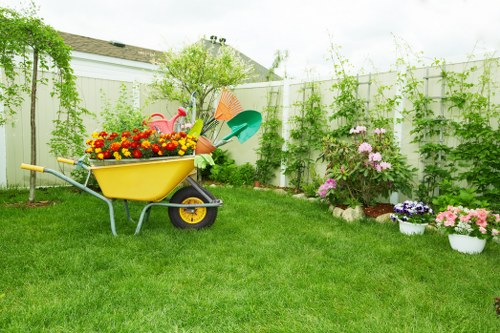Lawn Mowing in Chingford: Your Ultimate Guide to a Perfect Lawn

Introduction to Lawn Mowing in Chingford
Maintaining a beautiful lawn is a vital aspect of home aesthetics in Chingford. A well-mowed lawn not only enhances the visual appeal of your property but also promotes a healthy and vibrant garden environment. Whether you are a seasoned gardener or a novice homeowner, understanding the nuances of lawn mowing in Chingford can make a significant difference.
Chingford's climate and soil conditions present unique challenges and opportunities for lawn care. With the right approach, you can achieve a lush, green lawn that stands out in your neighborhood. This guide will delve into the best practices, tools, and tips for effective lawn mowing in Chingford.
From choosing the right mowing schedule to selecting appropriate equipment, we cover everything you need to know to keep your lawn in top shape all year round.

Understanding Chingford's Climate and Its Impact on Lawn Care
Chingford experiences a temperate maritime climate, characterized by moderate temperatures and adequate rainfall throughout the year. This climate is conducive to the growth of a variety of grass types, making it an ideal location for lush lawns. However, understanding the local weather patterns is crucial for effective lawn mowing.
The spring and summer months are particularly important for lawn growth. During these seasons, the grass grows rapidly and requires more frequent mowing to maintain its health and appearance. Conversely, in the fall and winter, growth slows down, and mowing can be reduced.
Additionally, the urban environment of Chingford means that lawns may face challenges such as reduced sunlight and higher foot traffic. These factors must be considered when planning your lawn care regimen to ensure resilience and vibrancy year-round.

Choosing the Right Grass for Your Chingford Lawn
Popular Grass Varieties
- Perennial Ryegrass: Known for its quick germination and vibrant green color, it thrives in the cool climate of Chingford.
- Fescue: Offers excellent shade tolerance and is highly resilient against foot traffic, making it ideal for lawns with heavy use.
- Kentucky Bluegrass: Praised for its lush texture and ability to recover quickly from wear and tear.
Selecting the appropriate grass type is essential for a healthy lawn. Consider factors such as sunlight exposure, soil type, and the level of foot traffic your lawn will endure.
A well-chosen grass variety will reduce maintenance efforts and ensure a lawn that remains green and healthy throughout the year.

Essential Tools for Lawn Mowing
Choosing the Right Mower
- Manual Reel Mowers: Eco-friendly and ideal for smaller lawns, offering precision cutting with minimal maintenance.
- Electric Mowers: Quiet and efficient, suitable for medium-sized lawns with a focus on eco-conscious homeowners.
- Gas-Powered Mowers: Powerful and versatile, perfect for large lawns that require heavy-duty mowing.
Investing in the right mower is crucial for achieving a clean and even cut. Consider the size of your lawn, your physical capabilities, and your preference for eco-friendly options when making your choice.
Regular maintenance of your mower, including sharpening blades and cleaning, will enhance its performance and prolong its lifespan.

Best Practices for Lawn Mowing
Mowing Frequency and Height
- Spring and Summer: Mow your lawn 2-3 times per week to keep up with rapid growth.
- Fall: Reduce mowing frequency to once a week as growth slows.
- Winter: Minimal mowing is required unless there is unexpected growth.
Maintaining the correct mowing height is equally important. Cutting the grass too short can stress the plants and make them susceptible to diseases. Generally, a mowing height of 2.5 to 3 inches is recommended for most grass types in Chingford.
Using a mulching mower can help recycle grass clippings, providing natural nutrients back to the soil and reducing the need for additional fertilization.

Seasonal Lawn Care Tips
Spring Lawn Care
Spring is the time for revitalizing your lawn after the winter months. Begin by raking to remove dead grass and debris, which helps improve air circulation and prepares the soil for new growth.
- Fertilization: Apply a balanced fertilizer to promote healthy growth.
- Aeration: Aerate the soil to alleviate compaction and enhance nutrient absorption.
- Seeding: Overseed any bare patches to maintain a uniform lawn.

Summer Lawn Care
During the summer, focus on maintaining moisture levels to prevent drought stress. Regular watering, preferably in the early morning, ensures that the grass remains hydrated without promoting fungal growth.
- Irrigation: Water deeply but infrequently to encourage deep root development.
- Mowing: Keep the grass slightly longer to shade the soil and retain moisture.
- Pest Control: Monitor for pests and treat promptly to prevent damage.

Fall Lawn Care
Fall is crucial for preparing your lawn for the coming winter. It is the time to strengthen the grass and ensure it remains healthy during the colder months.
- Fertilization: Apply a high-potassium fertilizer to enhance root strength.
- Leaf Removal: Regularly remove fallen leaves to prevent mold and fungal diseases.
- Final Mow: Give your lawn a final mow before winter, lowering the height slightly to prevent matting under snow.

Winter Lawn Care
While grass growth slows in winter, some maintenance is still necessary to protect your lawn from harsh weather conditions.
- Minimal Mowing: Mow only if necessary to prevent ice buildup.
- Avoid Heavy Traffic: Limit foot traffic to prevent compacting the frozen soil.
- Snow and Ice Management: Clear snow gently to avoid damaging the grass beneath.

Common Lawn Mowing Mistakes to Avoid
Mowing Too Short
Cutting the grass too short can weaken the plants, making them more vulnerable to weeds and diseases. Always adhere to the recommended mowing height for your specific grass type.
Ignoring Lawn Health
Failing to address underlying lawn health issues, such as pests or diseases, can lead to long-term damage. Regularly inspect your lawn and take proactive measures to maintain its health.
Improper Mowing Techniques
Using incorrect mowing techniques can result in uneven cuts and lawn stress. Ensure your mower is properly adjusted and mow in different directions each time to promote even growth.

Eco-Friendly Lawn Mowing Practices
Using a Reel Mower
Opting for a manual reel mower reduces carbon emissions and promotes healthier grass by providing a clean cut without shredding.
Mulching
Mulching mowers recycle grass clippings back into the lawn, providing essential nutrients and reducing the need for chemical fertilizers.
Solar-Powered Equipment
Consider using solar-powered lawn care tools to minimize your environmental footprint while maintaining your lawn effectively.

Hiring Professional Lawn Mowing Services in Chingford
Benefits of Professional Services
- Expertise: Professionals have the knowledge and experience to handle various lawn types and conditions.
- Efficiency: They can maintain your lawn consistently, ensuring it always looks its best.
- Equipment: Access to high-quality tools and machinery that may not be feasible for homeowners to own.
Hiring a professional lawn mowing service in Chingford can save you time and effort, providing peace of mind that your lawn is in capable hands.
Professional services often offer additional benefits such as fertilization, pest control, and seasonal clean-ups, ensuring comprehensive lawn care.

Choosing the Right Lawn Care Service
- Reputation: Look for services with positive reviews and a proven track record in Chingford.
- Services Offered: Ensure the company provides the specific services you require.
- Pricing: Compare quotes to find a service that offers good value without compromising on quality.
- Flexibility: Opt for a service that can accommodate your schedule and lawn care preferences.
Take the time to research and select a reputable lawn care provider who understands the unique needs of Chingford lawns.
Scheduling a consultation can help you assess their services and ensure they align with your lawn care goals.

DIY Lawn Mowing Tips for Chingford Homeowners
Creating a Mowing Schedule
Developing a consistent mowing schedule is key to maintaining a healthy lawn. Adjust the frequency based on seasonal growth patterns to ensure optimal grass health.
- Weekly Mowing: Typically required during peak growth seasons in spring and summer.
- Bi-Weekly Mowing: Suitable during slower growth periods in fall.
- As Needed: Minimal mowing in winter unless necessary.
Proper Mowing Techniques
Following proper mowing techniques can enhance the appearance and health of your lawn.
- Stay Sharp: Keep mower blades sharp for a clean cut.
- Vary Directions: Change mowing patterns to prevent grass from leaning in one direction.
- Don't Overlap: Avoid overlapping passes to ensure even cutting without stressing the grass.
Maintaining Your Mower
Regular maintenance of your mower ensures efficient performance and prolongs its lifespan.
- Blade Sharpening: Sharpen blades at least once a season.
- Cleaning: Remove grass clippings and debris after each use.
- Lubrication: Lubricate moving parts to prevent rust and ensure smooth operation.

Enhancing Lawn Health Beyond Mowing
Watering Practices
Proper watering is crucial for maintaining a healthy lawn. Water deeply to encourage deep root growth, and water in the early morning to minimize evaporation and reduce the risk of fungal diseases.
- Deep and Infrequent: Promote strong root systems by watering deeply but less frequently.
- Even Coverage: Ensure water is evenly distributed across the lawn.
- Avoid Overwatering: Prevent waterlogging and root rot by avoiding excessive watering.
Fertilization
Fertilizing your lawn provides essential nutrients that support growth and resilience.
- Balanced Fertilizer: Use a balanced fertilizer that provides nitrogen, phosphorus, and potassium.
- Application Timing: Fertilize during the growing seasons to maximize nutrient absorption.
- Organic Options: Consider organic fertilizers for a more environmentally friendly approach.
Weed and Pest Control
Managing weeds and pests is essential for a healthy lawn. Regularly inspect your lawn for signs of infestation and address issues promptly.
- Manual Removal: Hand-pull weeds to prevent them from spreading.
- Herbicides: Use selective herbicides to target specific weed types without harming the grass.
- Natural Predators: Encourage beneficial insects that prey on common lawn pests.

Legal and Environmental Considerations
Local Regulations
Familiarize yourself with Chingford's local regulations regarding lawn maintenance. Some areas may have specific guidelines on mowing times, noise levels, and waste disposal.
- Mowing Hours: Adhere to designated mowing times to minimize disturbance to neighbors.
- Noise Restrictions: Use quieter equipment or operate within allowed hours to comply with noise regulations.
- Waste Disposal: Properly dispose of grass clippings and other yard waste to prevent environmental impact.
Sustainable Practices
Incorporating sustainable practices into your lawn care routine benefits both the environment and your lawn's health.
- Composting: Compost grass clippings and organic waste to enrich your soil naturally.
- Native Plants: Integrate native plant species that require less maintenance and water.
- Water Conservation: Implement water-saving techniques to reduce overall water usage.

Advanced Lawn Care Techniques
Aeration
Aerating your lawn involves perforating the soil to allow air, water, and nutrients to penetrate the grass roots. This process helps alleviate soil compaction and promotes healthier growth.
- When to Aerate: Best performed during the growing seasons in spring or fall.
- Tools: Use a core aerator to remove plugs of soil for maximum effectiveness.
- Frequency: Aerate once a year for most lawns, or more frequently for heavily used areas.
Overseeding
Overseeding involves planting new grass seeds over an existing lawn to improve density and fill in bare spots. This technique enhances the lawn's resilience and appearance.
- Seed Selection: Choose a seed variety compatible with your existing grass type.
- Preparation: Mow the existing grass closely and rake to remove debris before seeding.
- Post-Seeding Care: Keep the soil moist until the new seeds germinate and establish.
Topdressing
Topdressing involves spreading a thin layer of soil or compost over the lawn to improve soil quality, smooth uneven areas, and promote healthy grass growth.
- Material Choice: Use high-quality compost or topsoil that matches your lawn's existing soil composition.
- Application: Spread evenly using a spreader or by hand, ensuring a consistent layer without smothering the grass.
- Benefits: Enhances soil structure, improves drainage, and provides essential nutrients.

Cost Considerations for Lawn Mowing in Chingford
DIY vs. Professional Services
When deciding between DIY lawn mowing and hiring professional services, consider the following cost factors:
- Initial Investment: Purchasing quality lawn equipment can be costly upfront but may save money in the long run.
- Maintenance Costs: DIY mowing requires regular maintenance of equipment, which can add to ongoing expenses.
- Time Investment: Mowing your lawn takes time, which could be allocated to other activities or responsibilities.
- Professional Fees: Hiring professionals involves a recurring cost but ensures consistent and high-quality lawn care.
Budgeting for Lawn Care
Creating a budget for lawn care helps manage expenses effectively while maintaining a beautiful lawn.
- Equipment Purchases: Allocate funds for purchasing necessary tools and machinery.
- Service Contracts: If opting for professional services, consider monthly or seasonal contracts for better budgeting.
- Supplies: Include costs for fertilizers, seeds, and other essential supplies in your budget.
Proper budgeting ensures that you can maintain your lawn without unexpected financial strain, allowing for both immediate and long-term care.

Enhancing Curb Appeal with Lawn Care
Symmetrical Mowing Patterns
Implementing symmetrical mowing patterns can significantly enhance the visual appeal of your lawn. Regularly changing the direction of mowing prevents grass from leaning and creates a uniform, professional look.
Edging and Trimming
Well-defined edges and trimmed borders provide a clean and polished appearance. Use edging tools to create sharp lines along sidewalks, driveways, and flower beds.
Incorporating Landscaping Features
Adding features such as flower beds, ornamental grasses, and garden sculptures can complement your mowed lawn, creating an inviting and aesthetically pleasing outdoor space.

Conclusion: Achieving the Perfect Lawn in Chingford
Maintaining a pristine lawn in Chingford requires a combination of proper mowing techniques, appropriate tools, and regular care. By understanding the local climate, selecting the right grass, and adhering to best practices, you can enjoy a vibrant and healthy lawn year-round.
Whether you choose to handle lawn care yourself or hire professionals, the key to success lies in consistency and attention to detail. Implementing the tips and strategies outlined in this guide will help you achieve the lawn of your dreams, enhancing both the beauty and value of your property.
Contact us today to learn more about professional lawn mowing services in Chingford or to book your service now and take the first step towards a stunning lawn.